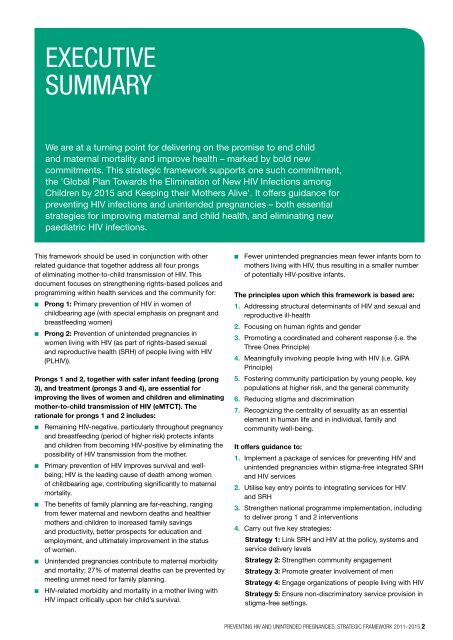PREVENTING HIV AND UNINTENDED PREGNANCIES ... - UNFPA
PREVENTING HIV AND UNINTENDED PREGNANCIES ... - UNFPA
PREVENTING HIV AND UNINTENDED PREGNANCIES ... - UNFPA
- No tags were found...
Create successful ePaper yourself
Turn your PDF publications into a flip-book with our unique Google optimized e-Paper software.
ExecutivesummaryWe are at a turning point for delivering on the promise to end childand maternal mortality and improve health – marked by bold newcommitments. This strategic framework supports one such commitment,the 'Global Plan Towards the Elimination of New <strong>HIV</strong> Infections amongChildren by 2015 and Keeping their Mothers Alive'. It offers guidance forpreventing <strong>HIV</strong> infections and unintended pregnancies – both essentialstrategies for improving maternal and child health, and eliminating newpaediatric <strong>HIV</strong> infections.This framework should be used in conjunction with otherrelated guidance that together address all four prongsof eliminating mother-to-child transmission of <strong>HIV</strong>. Thisdocument focuses on strengthening rights-based polices andprogramming within health services and the community for:■ Prong 1: Primary prevention of <strong>HIV</strong> in women ofchildbearing age (with special emphasis on pregnant andbreastfeeding women)■ Prong 2: Prevention of unintended pregnancies inwomen living with <strong>HIV</strong> (as part of rights-based sexualand reproductive health (SRH) of people living with <strong>HIV</strong>(PL<strong>HIV</strong>)).Prongs 1 and 2, together with safer infant feeding (prong3), and treatment (prongs 3 and 4), are essential forimproving the lives of women and children and eliminatingmother-to-child transmission of <strong>HIV</strong> (eMTCT). Therationale for prongs 1 and 2 includes:■ Remaining <strong>HIV</strong>-negative, particularly throughout pregnancyand breastfeeding (period of higher risk) protects infantsand children from becoming <strong>HIV</strong>-positive by eliminating thepossibility of <strong>HIV</strong> transmission from the mother.■ Primary prevention of <strong>HIV</strong> improves survival and wellbeing;<strong>HIV</strong> is the leading cause of death among womenof childbearing age, contributing significantly to maternalmortality.■ The benefits of family planning are far-reaching, rangingfrom fewer maternal and newborn deaths and healthiermothers and children to increased family savingsand productivity, better prospects for education andemployment, and ultimately improvement in the statusof women.■ Unintended pregnancies contribute to maternal morbidityand mortality; 27% of maternal deaths can be prevented bymeeting unmet need for family planning.■ <strong>HIV</strong>-related morbidity and mortality in a mother living with<strong>HIV</strong> impact critically upon her child’s survival.■Fewer unintended pregnancies mean fewer infants born tomothers living with <strong>HIV</strong>, thus resulting in a smaller numberof potentially <strong>HIV</strong>-positive infants.The principles upon which this framework is based are:1. Addressing structural determinants of <strong>HIV</strong> and sexual andreproductive ill-health2. Focusing on human rights and gender3. Promoting a coordinated and coherent response (i.e. theThree Ones Principle)4. Meaningfully involving people living with <strong>HIV</strong> (i.e. GIPAPrinciple)5. Fostering community participation by young people, keypopulations at higher risk, and the general community6. Reducing stigma and discrimination7. Recognizing the centrality of sexuality as an essentialelement in human life and in individual, family andcommunity well-being.It offers guidance to:1. Implement a package of services for preventing <strong>HIV</strong> andunintended pregnancies within stigma-free integrated SRHand <strong>HIV</strong> services2. Utilise key entry points to integrating services for <strong>HIV</strong>and SRH3. Strengthen national programme implementation, includingto deliver prong 1 and 2 interventions4. Carry out five key strategies:Strategy 1: Link SRH and <strong>HIV</strong> at the policy, systems andservice delivery levelsStrategy 2: Strengthen community engagementStrategy 3: Promote greater involvement of menStrategy 4: Engage organizations of people living with <strong>HIV</strong>Strategy 5: Ensure non-discriminatory service provision instigma-free settings.Preventing <strong>HIV</strong> and Unintended Pregnancies: Strategic Framework 2011–2015 2
















